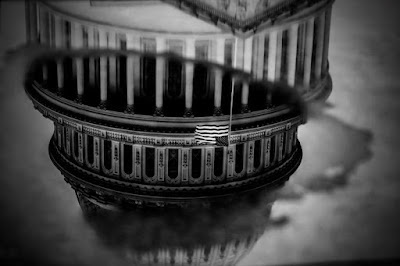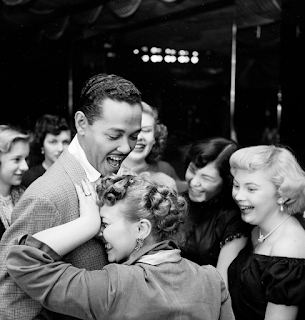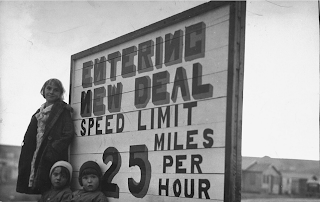February 29, 2024
Six pioneering women whose photographs for LIFE magazine skillfully captured events on a quickly evolving world stage will be the subject of Greenwich Historical Society’s new exhibition to debut March 6. These photographers enabled the public “to see life; to see the world; to eyewitness great events,” as described by LIFE magazine founder and editor-in-chief Henry Luce.
Martha Holmes, photograph from “Mr. B.,” LIFE, April 24, 1950 © LIFE Picture Collection, Dotdash Meredith Corp. Martha Holmes began photographing for LIFE in 1944. On view in the exhibition are Holmes’s 1950 photographs of mixed-race singer Billy Eckstine, including one of Eckstine being embraced by a white fan—a provocative image that Holmes felt was one of her best because she felt that it “told just what the world should be like.” Henry Luce supported this opinion.
LIFE: Six Women Photographers features iconic images from these talented women who helped create modern photojournalism through their work as featured in the pages of LIFE magazine.On view through July 7, 2024, the exhibition presents more than 70 photographs by
Margaret Bourke-White (1904-1971), Marie Hansen (1918-1969),
Martha Holmes (1923-2006),
Lisa Larsen (ca. 1925-1959),
Nina Leen (ca. 1909-1995) and Hansel Mieth (1909-1998).
“We are thrilled to showcase the works of these talented photographers who were on the vanguard of a transformative change in how twentieth-century Americans received and understood global cultural and political events,” said Maggie Dimock, curator of exhibitions and collections at Greenwich Historical Society.
“This insightful exhibition offers a glimpse into how each of these remarkable women used their camera to capture topics that dominated American discourse through the last century, including U.S. industrial strength, the role of women and the family in modern American society, race relations, World War II, labor movements and the Cold War.”
A long-time Greenwich resident, Henry Luce (1898 – 1967) was convinced that American political, economic, and cultural power would, and should, dominate the era and that photojournalism, or “photo essays” as he coined them, could effectively shape America as an international power, inspiring its people, in his words, “to live and work and fight with vigor and enthusiasm.”
For decades, Americans saw the world through the lens of the photographers at LIFE, and the magazine’s innovative photo essays became the publication’s trademark.
Of the 101 photographers on staff at LIFE during the magazine’s run as a weekly, only six full-time photographers were women. LIFE: Six Women Photographers highlights the work of these photographers while providing insight into the process through which they worked with editors to create visual stories, through the inclusion of photographs, vintage prints, copy prints and contact sheets. Published and unpublished photographs along with select memos, correspondence and other items from Time Inc. records show the editing process behind the final, published stories.
“The topic will provide fascinating historical context to the enormous changes underway today in media,” said Greenwich Historical Society Executive Director and CEO Debra Mecky. “And it will enable us to further our mission to strengthen the community’s connection to our past, to each other and to our future. Henry Luce was a Greenwich resident during the time he was arguably the most influential media figure in the twentieth century and one of the country’s most prominent citizens.”
LIFE: Six Women Photographers has been organized by the New-York Historical Society. The exhibition is curated by Marilyn Satin Kushner, curator and head, Department of Prints, Photographs, and Architectural Collections; and Sarah Gordon, curatorial scholar in women’s history, Center for Women’s History; with Erin Levitsky, Ryerson University; and William J. Simmons, Andrew Mellon Foundation Pre-Doctoral Fellow, Center for Women’s History. The New-York Historical Society holds the research archive of Time Inc., which was acquired by the Meredith Corporation (now Dotdash Meredith Corp.) in 2018.
A series of lectures, workshops and discussions, film screenings and other activity related to the exhibition will be presented by Greenwich Historical Society throughout the duration of the exhibition, beginning with two in March:
Women of Photos and Letters:
Margaret Bourke-White, Clare Booth Luce and Annie Leibovitz
Thursday, March 14 from 6:00 – 7:00 pm
In honor of Women’s History Month, Louisa Iacurci of the Connecticut Women’s Hall of Fame will explore the inspiring histories of Hall of Fame inductees whose work and lives are intertwined with social advocacy and journalistic activism, including photographers Margaret Bourke-White and Annie Leibovitz and writer, journalist and politician Clare Booth Luce.
LIFE: Six Women Photographers: A Lecture with Curator Marilyn Satin KushnerThursday, March 21 from 6:00 – 7:00 pm
In an illustrated lecture, Dr. Marilyn Satin Kushner, Curator and Head of the Department of Prints, Photographs, and Architectural Collections at New-York Historical Society, will expand on the curatorial process for LIFE: Six Women Photographers.
The full program schedule is available online:
https://greenwichhistory.org/life-six-women-photographers/












